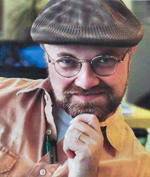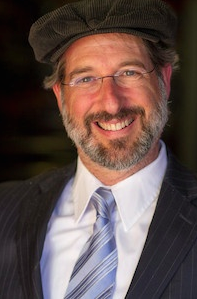By Eric George Tauber


SAN DIEGO — This city’s Jewish Arts Festival is now in its 22nd year. At the helm is Todd Salovey, Associate Artistic Director of San Diego REP. I recently spoke with Salovey at his home.
EGT: Mona Golabek: The Pianist of Willesden Lane, which won the Critic’s Circle Award for best one-person show, is coming back. At the awards, Hershey Felder said that it was traveling. Where has it been and where is it going?
TS: It’s had a really extensive life. Before it came to San Diego, it’d had an off-Broadway run in New York. Right now, as we speak, it’s at Hartford Stage Company. Before that, it was in Chicago. So it’s a production which is playing at major theatres around the country. In fact, it’s going back to New York. So, in some ways, it’s a tune up before its return to New York.
EGT: That is excellent. Now, I notice you have quite a bit of klezmer in the line-up. And that genre tends to draw an older crowd. At one concert, I seemed to be one of the younger people there. How would you bridge that generation gap?
TS: Well that’s actually a really good observation. Around the country, there’s really been a revival of klezmer music. In some ways, it’s because it’s world beat music. Part of it is older music from the Yiddish theater, but if you think about the influences on klezmer, especially American klezmer, you’re seeing multiple influences. You can see American jazz in the way it’s played. You can also hear some strains of gypsy music in it. I think there’s a kind of exotic virtuosity that’s in klezmer that can appeal to people of all ages.
One of the interesting things we’re doing at the Klezmer Summit at the Lyceum is we’re showing some of the influences of European classical music. We’re very fortunate to have Rachel Barton Pine, who’s a world-class violin soloist, who plays classical and klezmer. And she also plays heavy metal. So we’re very interested in the feeling that she brings.
EGT: Heavy metal violin?
TS: She does. If you Google her, you’ll see that it’s one of the things she specialized in.
EGT: Interesting. Now you always include some Spanish in the festival. Why is this group particularly important to you?
TS: Well, the Mexican-Jewish community has a real love of Jewish art and culture. And the Rep has always had an appeal to a Spanish-speaking audience. In some ways, they’re one of the most loyal constituencies of the festival. Bringing back Teatro Punto y Coma is very exciting because they’ve premiered many shows in the festival. And I remember the very first time that I introduced them. This was a long time ago. I think it was at the third festival. I came onstage and said, “Tomorrow’s show is by Teatro Punta y Coma, a group of Mexican-Jewish actors and their show is in Spanish.” And the audience laughed at me. And I said, “Don’t laugh. It’s sold out.”
As they’ve gone, they’re trying to reach a broader audience by doing work that has some Spanish in it, but is primarily in English. I’m very proud that we’ve co-produced with them and with the Ken Jewish Community, which is the cultural center of the Mexican-Jewish community. The flamenco shows that we’re doing in Oceanside will also be very attractive to a Spanish-speaking audience.
EGT: How do you choose the people whom you profile in the “Women of Valor”?
TS: They’re primarily chosen by the group of writers. This group has been writing together for many years. We talk about the kind of experiences and giving to the community and the kind of women that we’re looking for. And we’re also looking for people who have made a contribution to the Jewish community and the greater San Diego community, often very quietly.
One of the things that we’re always interested in is how being Jewish has influenced the work that you’ve done and the decisions you’ve made. How has being Jewish helped you face certain challenges that you’ve faced in your life? We’re looking for people that have a variety of stories to tell. And we always have far more women than we could possibly profile in a year.
If you look at the women, you look at Gussie Zaks, she’s a Holocaust survivor who has spent decades educating people about the Holocaust experience.
You have Helene Bortz who is one of the founders of San Diego Gift Closet, which is like a free loan society not just for money. They give things like wedding dresses, furniture and baby clothes. They give so much help to people who are in need in the community.
Fern Siegel has been involved in Chesed Home, which gives a place to live and treatment to people who are mentally ill.
Police Chief Zimmerman is out front and center leading law enforcement in San Diego.
So there’s a huge variety of people. In some ways, I’m looking for people who inspire me, our writers and the audience.
EGT: If somebody is not Jewish, what do you think they might get out of this festival?
TS: Well, what’s interesting is that over the years, more and more of our audience is not Jewish. They’re just interested in the art that we’re doing. You know, when you talk about Hershey Felder doing the Great American Songbook Sing-along and the Pianist of Willesden Lane, you’re talking about performances that are of the highest caliber. It makes me proud that we can make that work available to San Diego.
Whatever a person’s background is, Mona’s story is so touching and inspiring. Hershey gets an entire theater to sing along to great songs from American musicals that we all know. They’re just communal experiences that are hard to match at any venue. I think that we’re always looking at how Jewish ideas and Jewish art is part of the dialogue of the larger community that it’s in.
So it’s not meant to be exclusive in any way. It’s really looking for a commonality between people and to make the arts a place where people can enjoy things that have a Jewish center, but can appeal across cultures.
EGT: Where do you see this festival changing over the next 20 years? I can see how it’s definitely grown. What would you like to see that you haven’t yet?
TS: The thing that most excites me about the festival is that we’re giving birth to new work. It starts here and then you see it at venues around the country and around the world. It’s one of my goals that we should continue to be the birthing place of new work. Another thing that I see –and you’re seeing it this year at the festival- is having longer runs at larger venues so that the profile of our work is greatly expanded. I think that’s one of the long-term goals for the festival. We’re partnering with other organizations, so that we can do work that can be seen and spoken about by more people.
*
The 2015 San Diego Jewish Arts Festival runs from May 21st to July 26th at multiple venues around the county. For show times and ticket prices, go to https://www.sdjewishworld.com/2015/04/07/2015-jewish-arts-festival-schedule-announced/
*
Tauber is a freelance writer who specializes in coverage of the arts. You may comment to him at eric.tauber@sdjewishworld.com, or post your comment on this website provided that the rules below are observed.
__________________________________________________________________
Care to comment? We require the following information on any letter for publication: 1) Your full name 2) Your city and state (or country) of residence. Letters lacking such information will be automatically deleted. San Diego Jewish World is intended as a forum for the entire Jewish community, whatever your political leanings. Letters may be posted below provided they are responsive to the article that prompted them, and civil in their tone. Ad hominem attacks against any religion, country, gender, race, sexual orientation, or physical disability will not be considered for publication. There is a limit of one letter per writer on any given day.
__________________________________________________________________